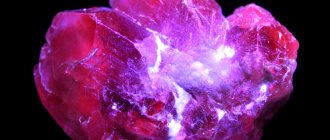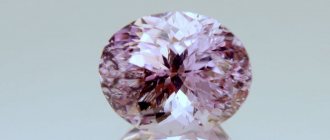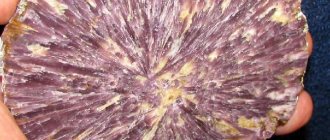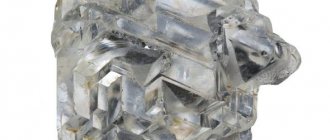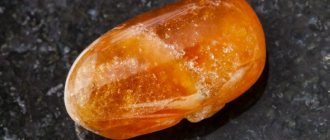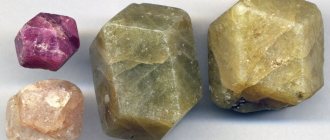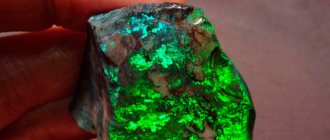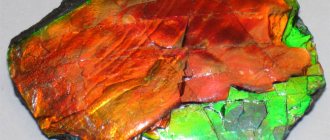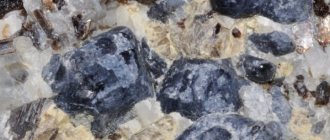Sultanite (aka Diaspora) is often called a chameleon, since its color actually changes depending on the lighting. It is produced in abundance in deposits in Turkey, but is popular in all countries of the world. Its main advantage is that it changes color, and no one can say exactly how this happens.
Unprocessed sultanite
It is believed that twilight affects the surface so that it acquires greenish tints, but if the sun shines brightly or there is bright artificial lighting, the color changes to a more saturated one, becoming yellow, brown, amber. But, of course, it’s not just light that influences, the presence of impurities matters. Impurities include shades of pink, yellowish, purple, crimson and other tones. The stone looks great in combination with silver and gold; it attracts attention with a pleasant pearlescent shine, and after careful polishing and cutting it becomes even brighter and richer.
Colors and varieties of tanzanite
In terms of structure and chemical composition, tanzanite is zoisite, only blue in color, based on calcium and aluminum compounds. The luxurious, deep color of the stone is due to the presence of small amounts of vanadium and chromium. Moreover, the stone is characterized by pleochroism - the ability to change shade at different angles of inclination relative to the light source.
Tanzanite is not inferior in beauty to sapphire, but is much more fragile, and also has perfect cleavage, which is why few jewelers are willing to process it. One awkward movement - the mineral splits into small pieces.
Chemical and physical characteristics of Tanzanian stone (Ca2Al3(SiO4)(Si2O7)O(OH)):
- hardness – 6.5–7 Mohs points;
- refraction – 1.692–1.7;
- density – 3.35 g/cm3;
- transparency – high;
- cleavage – perfect;
- fragility – high;
- shine – glass;
- syngony – rhombic;
- the fracture is uneven.
The crystals found in the Tanzanian subsoil are greenish-brown. To obtain a deep blue color, tanzanite must be heated to 600 °C.
This manipulation is easy to perform in laboratory conditions, but in nature, a rich blue color appears when the stone is exposed to direct ultraviolet light or a stream of gushing lava. Therefore, magnificent violet-blue crystals lie either near the earth's surface or in close proximity to a volcano.
Natural specimens of blue color are rare and highly valued in the jewelry market. More often, refined stones – those subjected to high-temperature exposure in laboratory conditions – go on sale.
Attention! The magical properties of the stone do not depend on how the coloring was obtained, so it is quite possible to use an ennobled specimen as an amulet.
The most popular color is deep violet-blue, but there are specimens of other colors:
- pale blue;
- dark blue;
- pale blue with a purple tint;
- gray;
- gray-blue;
- bluish-green;
- pink;
- colorless;
- greenish-brown (deep, not exposed to temperature or ultraviolet influence);
- with a “cat’s eye” effect (the rarest).
The glorious history of the Sultanite
Mention of the Sultan is found in the treatises of Eastern sages. The sultans gave preference to this mineral, generously decorating their clothes with it and giving it to their wives and concubines. There are small deposits in the vicinity of Yekaterinburg, but the quality of the minerals of the Urals is inferior to their Turkish counterparts, which are considered the standard of quality and purity. However, the stone was first found in the Urals.
Diaspora, thanatarite and zultanite are other names for the stone
Translated from Greek, “diaspora” means “scattering,” so people focused on the fact that its surface scatters light. In Russia, the name “tantarite” is also in use, in honor of the Soviet geologist Tanatar Joseph Isaakovich, plus, in Turkey itself the name “zultanite” is in use, but there are other variations.
Sultanite under daylight and artificial light
Medicinal properties
Tanzanite can be used as an addition to the main therapy of many pathologies, as it has a variety of therapeutic effects on the human body:
- relieves migraines of varying intensity;
- accelerates recovery from infectious diseases;
- strengthens the immune system, helps prevent viral respiratory diseases (recommended to wear during the cold season);
- helps cope with comedones, pimples, and other inflammatory skin rashes (it is useful to wash your face with a mineral infusion, for the preparation of which the stone is immersed in water for an hour);
- relieves visual fatigue and eye irritation (you should look at the stone for several minutes);
- smoothes wrinkles (facial massage with a stone helps);
- develops fine motor skills (rings should be worn);
- relieves joint pain (massage the affected area of the body with a stone);
- normalizes the state of the nervous system, gets rid of depression, anxiety, panic, fills with calmness and optimism;
- eliminates insomnia (you should put tanzanite under your pillow).
A little about the deposit
In Russia, deposits can be found only in the Middle and Southern Urals, in the Republic of Sakha-Yakutia. There are also stone deposits in Azerbaijan, China, Uzbekistan, and the USA. The most durable stones, respectively, suitable for processing and making jewelry, are mined in the Lake Bafa region, Turkey. After professional cutting, gems up to 25 carats are obtained. It is not surprising that the stone is very popular, so it is recommended to purchase it not only for aesthetic pleasure, but also as an investment.
Magic properties
The expensive appearance and luxurious color of tanzanite hint that the magical properties of the mineral are associated with attracting wealth and prosperity in all areas of life.
Tanzanite is a talisman for businessmen, business people, and careerists. It helps you determine your professional purpose, successfully start a business, enter into profitable contracts, contact reliable and experienced partners, and achieve material well-being.
The talisman has a positive effect on the personal life of the owner, making him more attractive to people of the opposite sex. The lonely owner of the stone manages to meet his soul mate and create a strong and prosperous family. Women who dream of finding true love should wear earrings with a stone. Tanzanite in a ring is recommended for girls who want to get married sooner.
Important! Tanzanite does not tolerate frivolous and forbidden love relationships. He will certainly punish the owner who is carried away by flirting and affairs with a worsening financial situation.
For a family man, tanzanite is a talisman for preserving marital relationships, preventing quarrels, betrayals, and conflicts. The mineral helps a person who finds himself in a difficult situation find the right solution. Tanzanite is a popular attribute of magical rituals. It enhances magical abilities and helps to immerse oneself in meditation.
Who is suitable for diaspora or sultanite
Stephen Webster pendant with diamonds and sultanite
Astrologers believe that the diaspora is at the mercy of the element of fire. Among the zodiac signs, sultanite is most suitable for Sagittarius, Leo and Aries. It will bring them health, good luck, and will become a talisman and talisman.
In addition, Taurus, Virgo and Capricorn can count on help from the diaspora. These signs are characterized by some tightness and limited emotions. The sultanite stone will reveal the emotional sphere, invigorate and give cheerfulness.
Compatibility with other minerals
Tanzanite is an exquisite and self-sufficient mineral; it does not need a neighbor. Other stones only distract attention from its beauty. The only optimal combination is a large tanzanite surrounded by small diamonds.
It is permissible to combine tanzanite with amethyst and citrine if you want to find love, and with topaz if you want to achieve career success. Unmarried girls who dream of becoming happy wives or successful careerists are allowed to combine tanzanite with ruby.
Description and origin
The amazing stone prehnite (other names: capsian emerald, adilite, chiltonite, edel) is a calcium aluminosilicate in the form of short columnar formations with a dense and crystalline structure. The composition contains various impurities, for example, calcium, magnesium. The gem has a characteristic shine, reminiscent of a glass glow. The mineral is susceptible to high temperatures and begins to melt when exposed to fire. The mineral is found to be completely transparent, and partially translucent.
Prehnite has a wide color palette. It has the following shades:
- yellow;
- green;
- brownish;
- white;
- light green, sometimes with a gray tint.
Despite its hardness, prehnite is ductile, brittle and easily bent. The stone received its name in honor of Colonel Hendrik van Prene, who was interested in minerals. But his knowledge was not enough to understand that his find was a real piece of jewelry, for which jewelry connoisseurs were willing to pay a considerable amount of money. At first, prehnite was compared to emerald and chrysolite. Stones are usually named after the city where the mineral was found, for example, sarinite received its name because of the city of Zarinsk. And a stone like Tengizite is named after the Tengiz oil field. This is an amazing mineral that appeared as a result of an explosion and fire. Tengizite is distinguished by its extraordinary beauty even in its raw form, and its decorative qualities are easy to notice for the average person.
Mining locations
The mineral is mined in different countries, with high-quality specimens found in Northern Kazakhstan.
The little-known prehnite stone was discovered in France, Germany and on the Austrian continent. There are other deposits of the mineral, namely:
- China;
- Scotland;
- USA.
The gem can be found near volcanic areas, shallow or on the surface of the earth, and it also fills cracks and voids. Prehnite is mined in New Zealand, Russia and India. Depending on the area, there are distinctive specimens with a characteristic color palette. High-quality specimens are found in the area of Northern Kazakhstan.
How to distinguish from a fake?
Zoisite has many fake analogues, which can be distinguished from analogues by:
- The nature of the black inclusions. In a fake, these inclusions are arranged in a chaotic manner and have shapeless dimensions.
- The presence of corundum. Natural stones have a small amount of corundum, but imitations are almost completely strewn with them, since they are produced by dyeing them crimson.
Meaning of zodiac signs
Blue Tanzanite is recommended to be worn by Aries who is hot-tempered and unrestrained in passions. This stone will help them keep their feelings in check, be calm, reasonable and chaste.
For Leos and Sagittarius, wearing jewelry interspersed with tanzanite, it also bestows calmness, the ability to control oneself and control one’s emotions.
Water signs - Pisces, Aquarius and Cancers - must have jewelry with Tanzanite at their disposal, since it is considered their talisman.
For people born under other zodiac signs, this stone may or may not help. Everything will depend on how much you like the jewelry. Stones with strong magical abilities prefer to choose their own owner.
Having purchased jewelry with tanzanite, you need to hold it in your palms for a while and listen to the sensations. If your palms become warm, the sensations are pleasant, and your mood has improved significantly, then the stone will bring you good luck. If a chill appears in your palms, and your heart becomes anxious, then it is better to put this decoration aside for now.
Decorations
According to history, for half a century, zoisite was used exclusively as a cheap stone used for various types of decoration.
In 1954, high-quality rocks of the mineral with beautiful variegated shades were discovered in Tanzania.
At the same time, jewelers became interested in the stone. A little later, in 1967, rare types of zoisite with a transparent structure were discovered, which subsequently became widely used in jewelry.
Zoisite has several varieties, each of which has found its current application in the field of jewelry creation. For example, opaque minerals are ideal for creating jewelry, but transparent ones are ideal for expensive jewelry.
Zoisite jewelry is spectacular and unique, which is why it is perfect for bright women who are used to attracting everyone's attention. The stone perfectly emphasizes their beauty and individuality.
This is interesting: zoisite rings are not put into mass production because they are in low demand due to their fragility. Moreover, it is rings that are lucky amulets.
The gem is devoid of any danger or hidden negative energy, making it suitable for everyone who wants to experience positive emotions.
